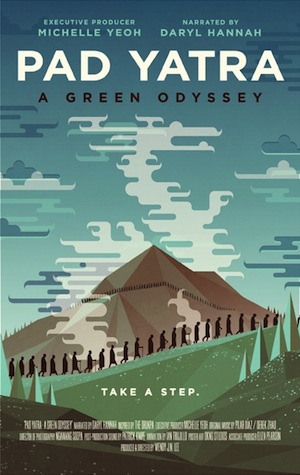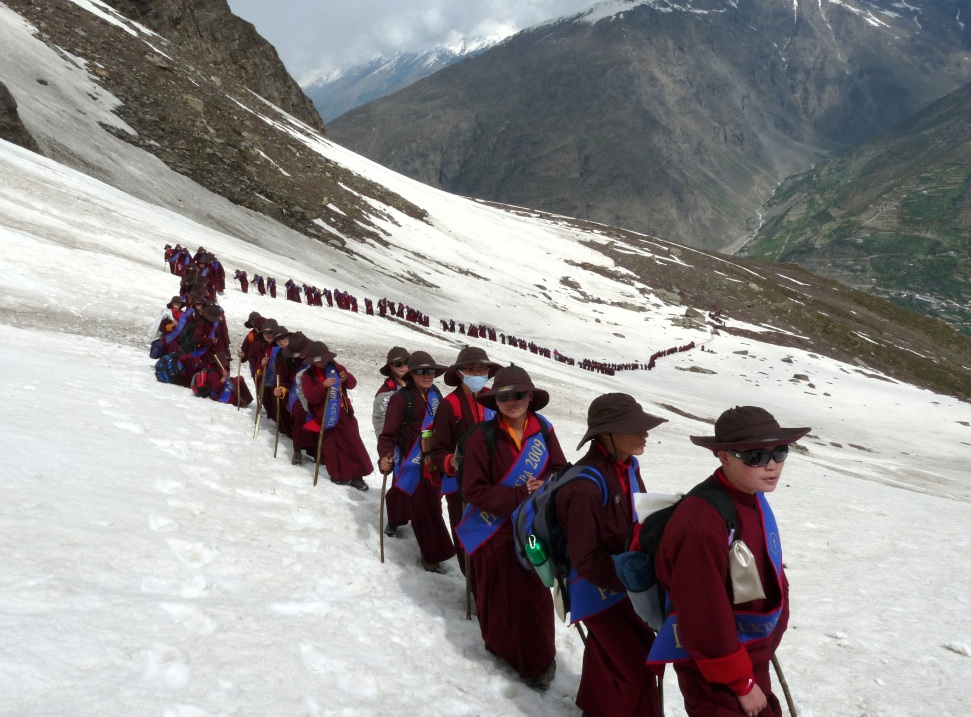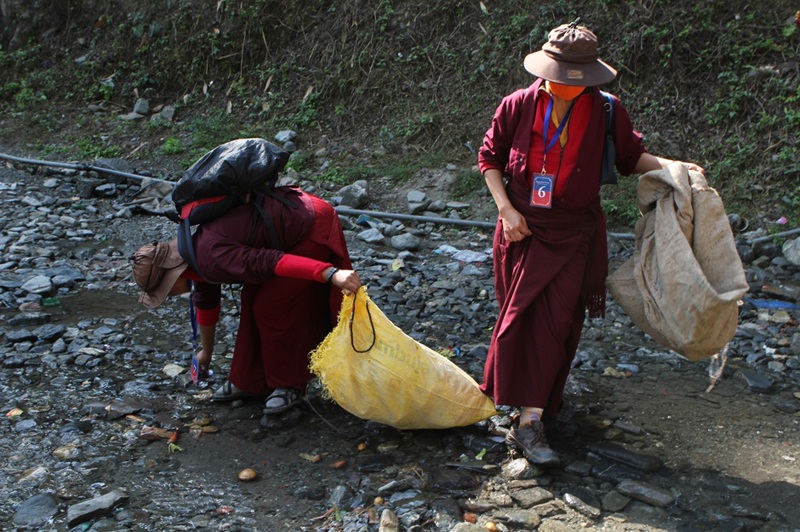With the largest store of glaciers outside of the polar ice caps, the Himalayas has been coined the “Third Pole” of the earth. Like at the other poles, the effects of rising global temperatures are dramatically destabilizing the local ecosystem. Unusual and often catastrophic weather occurrences are increasing each year, and people who live in the area worry that their way of life may be obliterated.
Pad Yatra: A Green Odyssey opens in Ladakh, India (“Little Tibet”) during the aftermath of a freak weather phenomenon known as a “cloudburst.” Several inches of rain fell in the first 60 seconds, decimating the area with mudslides and flash floods. As incidences like this increase, entire cultures are under threat of dispersion, not because of genocide or war, but by the chaos associated with global warming. A cry for survival, the eco-focused “Pad Yatra,” or spiritual walk, seen in this award-winning documentary was designed to spread the message of environmental compassion. Walking through perilous terrain while collecting trash and plastic from water sources, the 700 trekkers on the Pad Yatra educated remote villages on reusing non-biodegradable materials and planting trees. Led by His Holiness the Gyalwang Drupka, one of the main Buddhist spiritual leaders of the Himalayas, the trek covered a total of 450 miles and lasted well beyond its original plan of 42 days. Half a ton of plastic litter was collected by the participants, local residents were educated on environmental responsibility, and 50,000 trees were planted on the route. The difficult but inspiring journey has left the Himalayas changed forever. Director Wendy J. N. Lee, a participant in the Pad Yatra, documented the challenges and triumphs of the trek and how it led to a newfound environmental movement across the rooftop of the world. Pad Yatra: A Green Odyssey is narrated by actress and environmental activist Darryl Hannah and was produced by Michelle Yeoh. I sat down with Wendy J. N. Lee in Los Angeles.
 Danny Miller: Watching this beautiful film, I wanted to go on the Pad Yatra more than anything in the world, but the six-week trek seemed beyond arduous. I worry that I wouldn’t make it past the first day!
Danny Miller: Watching this beautiful film, I wanted to go on the Pad Yatra more than anything in the world, but the six-week trek seemed beyond arduous. I worry that I wouldn’t make it past the first day!
 Wendy J. N. Lee: I know what you mean, but it’s strange — once you’re in that situation, you realize that you’re capable of so much more than you think you are!
Wendy J. N. Lee: I know what you mean, but it’s strange — once you’re in that situation, you realize that you’re capable of so much more than you think you are!
You had over 700 people on the trek. I know one of the goals of the trip was to have as light a footprint as possible on the terrain. How is that possible with such a big crowd?
We didn’t leave anything behind. We didn’t bring toilet paper, for example, we had handkerchiefs and reusable cloths — not to gross anyone out! We dug the appropriate trenches and spaced them out appropriately.
How did you sleep?
In sleeping bags and tents, with lots of rocks in our backs! It’s funny the things you take for granted — we never once slept on a flat surface so I always woke up at the bottom of my tent because of the angle I was sleeping on! I used to have really bad insomnia but I haven’t had a single night of bad sleep since I got back from the Pad Yatra!
Did you have to worry about wildlife in the Himalayas?
We never encountered any dangerous animals during the trip. Remember, we were at a very high altitude, there weren’t even mosquitoes! We did see a lot of dead animals along the way, though, which wasn’t something I was used to. Natural deaths, circle of life kind things. There was this one time when we passed a horse who had clearly died giving birth — she seemed to be in mid-scream. I burst out crying when I saw it but that kind of thing didn’t faze the locals at all.
All that plastic garbage you picked up — did that come from hikers or local residents?
Both, but it was predominantly from tourists.
What kind of people go all the way to the Himalayas and then just toss their water bottles out like that?
Very tired people with altitude sickness who don’t want to carry the weight. And remember — we assume there’s some sort of trash disposal system everywhere but there isn’t.
Shlepping that much plastic garbage was quite a feat. Was it mostly water bottles?
Yes, and potato chip bags, remnants of all kinds of plastic containers, and lots of plastic bags.
Plastic is obviously the scourge of our planet. And it lasts forever. You’d think they could develop a water bottle at this point that would be completely biodegradable.
We do have bio-based plastics but it’s a question of scale and priority. Right now those things are too expensive. But as a result of the Pad Yatra, many of those areas have now banned plastic materials from coming in. The local people have started new businesses where they sell filtered water to tourists in canteens and other receptacles.
That’s great!
People are definitely catching on in the Himalayas. And as you see in the film, tree planting has become a huge craze in the area. They’ve now broken two Guinness Book of World Records. I think they planted over 100,000 trees last year!
Traveling with His Holiness the Gyalwang Drupka had to be amazing. Is he very well known in that part of the world?
Oh yes, and many people we’d encounter would just start weeping on the spot when they met him and realized he had walked there to see them. It was very moving. Pad Yatra is a tradition in that area. It’s a spiritual journey but His Holiness kind of repurposed it to have an environmental message as well. We attracted people of all faiths on the trip.
Filming in that harsh environment couldn’t have been easy. I know you were using a solar-powered camera because you had no access to electricity.
Yes, which meant that sometimes we only had a few minutes before the battery would go out. Our cinematographer, a wonderful monk named Ngawang Sodpa, had his work cut out for him. Unfortunately, because of the extreme weather, a lot of our tape got damaged and was unusable.
That must have been heartbreaking.
I saw him a few months ago when I was volunteering in Nepal and he started describing some of the shots we lost. It was devastating to hear, but it’s very difficult working with batteries at those temperatures — many times the camera would just shut off!
With that many people on such a long and difficult trek, I wondered if the any interpersonal issues came up. Did everyone get along or were there a lot of conflicts?
(Laughs.) That’s a great question, I would say yes, there were conflicts, especially with the Westerners who came on the trip. To be honest, in the beginning, everyone was very grouchy, myself included. We were just overwhelmed. But after the third or fourth day, everything started to seem okay. Suddenly you looked at people and they didn’t seem as irritating as they did a few days earlier! It’s a really weird thing but the way you view people starts to change in that kind of situation. You start to become a kind of family.
Did you have moments when you thought, “What the hell am I doing here?”
Oh God, yes! (Laughs.) Absolutely. And then you get over it and you feel so happy that you’re there and you can feel everything changing. You end up discovering that you’re capable of so much.
What do you hope that people take away from this film?
That this is not just a film about what’s happening in the Himalayas, it’s about all of us and whether we’re going to make decisions that show we care about our planet. The people in these villages are dying because their water supply is being poisoned by all the plastic. But I also hope the film has a different tone from other documentaries about this subject. I feel like environmental messages are usually wrapped up in a lot of fear tactics and cynicism. Making any positive changes seems so daunting. We wanted to touch on these issues with a different attitude — with humor and kindness and love. Yes, it can be seen as a pretty bleak picture but I doubt anything will change if we only view it from that lens.
Watching the film made me think about having my family doing our own Pad Yatra right in our neighborhood, picking up trash wherever we go.
Perfect. I think we all know what we can do in our communities. It’s up to us to empower ourselves and come up with solutions.
Would you say you came back from this trip a changed person?
It’s funny — about a month after I got back I realized I was more tolerant of people. I’m kind of a neurotic person and I think going on the Pad Yatra undid a lot of my neuroses! You couldn’t control a single thing on that trip so when you got home you didn’t try to control as much as you used to. I don’t get upset about little things as much as I did before — that was really an unexpected benefit!
Pad Yatra: A Green Odyssey is currently playing in Los Angeles. Check out the website to find screenings in your area and to see how you can participate in the next Pad Yatra.


